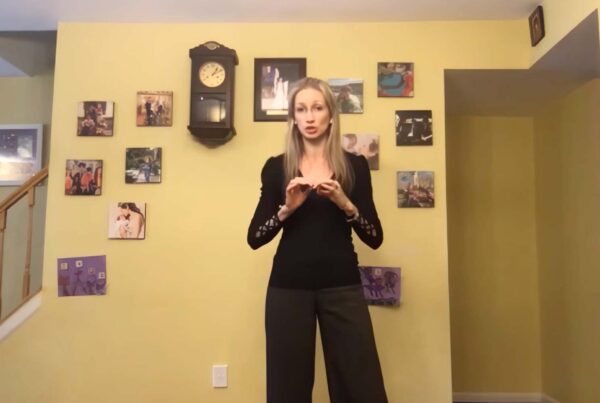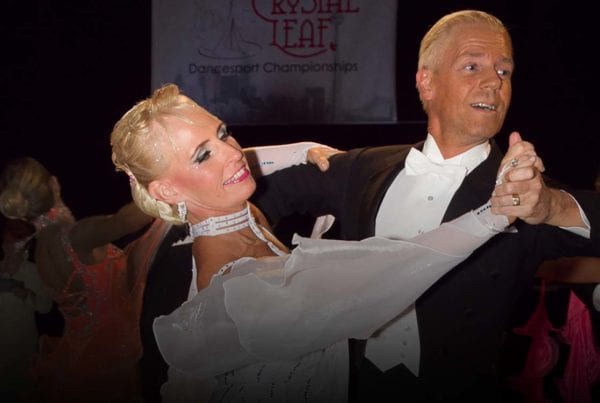I recently came across a series of notes I had made while attending the Professional Congress Workshops at the Embassy Ball a few years ago. There were several great presentations, but I especially appreciated the clarity and power of the lecture by Barbara Ambroz, a top adjudicator and one of the presenters. Here’s a look at my notes.
There is no fast track to quality ballroom dancing.
Barbara started her lecture by pointing out that there’s no fast track to ballroom dancing with quality. It takes time, effort and discipline. Her emphasis, as it so often is in these sessions, would be on some classic mistakes being made even by experienced competitive couples. I looked around the room and realized that with an audience composed of adjudicators, teachers and championship level dancers, she was still going to focus on the basics. A great lesson in how important it is to be grounded in the foundations of ballroom dancing!
Barbara introduced the couple who would assist her lecture, and I was pleased to see that it was the 11-year partnership of Paolo Bosco and Sylvia Pitton, one of my favorite Standard couples. Paolo and Sylvia demonstrated a beautiful basic Slow Foxtrot.
Moving in harmony
Barbara pointed out that the goal of ballroom dancing is to synchronize the harmony of the movement between the two partners. They must dance together as seamlessly as possible, coordinated expertly to the music.
Before we can dance together, we need to look at the individual roles of the man and lady. Think back to your first effort in the dance studio. Your teacher would first give you a pattern of steps, where all you think about is the direction you are moving and your foot positions. The attention in those early days is just where the feet are going. There is no awareness yet of body flight. There is no awareness of your partner. There is little understanding of what it means to lead in such a way that your partner can move in harmony with you. There is no comprehension yet of dynamic shaping and other elements that get layered on with experience. Unfortunately, as we layer on these other elements we lose sight of the foundational rules that make great dancing possible. This would be the emphasis of Barbara’s lecture.
It’s important that we know much more about other aspects of technique to progress into a great dancer. Barbara then explored some basic technique.
In the first step of the Slow Foxtrot, our upper body is angled at a slightly different way than the foot action that must take place. So we must understand this.
One extreme is to move the body back (leaning back) because the leading foot moves forward too early. The opposite extreme is to fall forward because the leading leg doesn’t move soon enough. They must synchronize. The standing leg produces the action, but it must be coordinated with the body weight above it so that your posture isn’t negatively affected.
Barbara showed how Sylvia must use the same technique as the man — using the standing leg to initiate the movement and not allow the free leg to move too early or too late.
She asked them to dance the Feather Step together to demonstrate the leg movement coordinated for freedom of movement without affecting the body.
Turns
In the Reverse Turn and back steps, a common problem is that the heel touches the ground too early. This causes the upper body to be back weighted. Paolo demonstrates the difference.
You should be able to see the heel of the man when he moves back, articulating his ankles. If the ankle movement is too weak, the foot won’t point properly causing the heel to be hidden.
Barbara uses Paolo and Sylvia to demonstrate another common synchronization problem, the lady pushing her center too far forward, or being too strong in her back stretch, causing the man to force a reaction which destroys the synchronization.
If the lady leans back too far, the man is forced to lean back and he is no longer upright and strong looking. It also makes him become stronger in his upper body to compensate, which destroys the lightness of the dancing.
Barbara dances with Paolo to show how a Change of Direction requires the man to transmit the right information to the lady, depending on what he wants to do next. I find this an interesting lesson: If he wants to simply stay there and change shape, he must keep his body weight over the standing foot. The free foot simply moves to the side with no weight transfer. On the other hand, if he wants to move forward, he must project his body weight from the standing leg forward so the lady knows ahead of time that he wants her to move back. If he wants to move forward, he must transmit that through the standing leg.
Barbara points out how, when she first learned to dance, it was actually easier to be in harmony with the man because she didn’t know what she was doing. Women often try to help the man as they get more experienced, which destroys synchronization.
To finish the lecture, Barbara asks Paolo and Sylvia to dance together, and they dance beautifully to demonstrate these principles. She also points out that spins and pivots can cause a lot of problems in maintaining the center. This happens because the man often turns his right side away too quickly, which breaks the picture. In my own teaching experience, I’ve found even more problems with the man leaving his right side behind too long, making it hard for the lady to turn in harmony with him.













